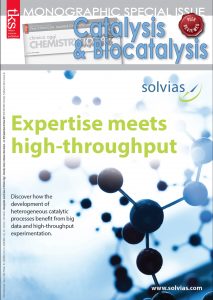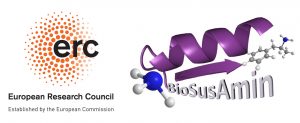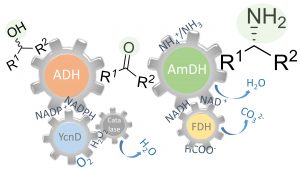
October 2017: Two new publications by HIMS-Biocat
The HIMS-Biocat group is currently engaged, among the others, in a project funded by the European Research Council (ERC), whose aim is the design and development of efficient biocatalytic cascades and biosynthetic pathways for the sustainable production of amines.
Following our break-through publication in Science on the dual-enzyme hydrogen-borrowing amination of alcohols and the further elucidation of the substrate scope and catalytic properties of synthetically useful amine dehydrogenases (published in Green Chemistry), we have presented a novel artificial and orthogonal biocatalytic network for the quantitative and stereospecific amination of alcohols. This work appeared in the latest issue of Organic and Biomolecular Chemistry.
Amines, and in particular α-chiral amines, are key intermediates for the production of active pharmaceutical ingredients, fine chemicals and agrochemicals. Structurally simpler amines are also of interest for the manufacture of polymers, dyestuffs, pigments, emulsifiers, and plasticizing agents. In our latest publication, we demonstrated that structurally diverse alcohols can be directly converted into (R)-configured enantiopure amines with quantitative conversion. The system is based on the combination of two redox-neutral modules. The first module, driven by an NADP-dependent alcohol dehydrogenase and an NADP-oxidase, oxidizes racemic secondary or primary alcohols to ketones or aldehydes at the expense of innocuous molecular oxygen. The second module, driven by an NAD-dependent amine dehydrogenase and an formate dehydrogenase, performs the asymmetric amination of the carbonyl compound intermediate. As the two enzymatic modules have a divergent co-enzyme specificity (NAD vs NADP), multiple redox reactions run simultaneously in the same vessel without the need for a physical separation.
This property in chemistry is defined as “orthogonality”. Orthogonal chemical reactions are very rare as traditional chemical (redox) reagents are not selective. In contrast, our system profits of the exquisite selectivity of enzymes to use and recycle a particular source of “nature hydride” (NADH or NADPH). Besides virtually perfect chemo-selectivity for the nicotinamide co-enzyme, amines were obtained in >99% enantiomeric excess as a result of the perfect stereoselectivity of amine dehydrogenases.
Despite this excellent selectivity, the applicability of our artificial biocatalytic network is not limited to a particular type of alcohols as substrate. Conversely, our system is “substrate promiscuous” as diverse alcohols could be aminates (e.g. aliphatic, aromatic, aryl-aliphatic).
Future work aims at improving the catalytic efficiency and further expanding the substrate scope of our two systems for the biocatalytic amination of alcohols (i.e. dual-enzyme hydrogen-borrowing amination & orthogonal biocatalytic network) with potential for application in industry.
The combination of an alcohol dehydrogenase with an amine dehydrogenase for the direct and asymmetric conversion of alcohols to α-chiral amines is probably the most outstanding example of hydrogen-borrowing cascade. Nevertheless, many examples of biocatalytic hydrogen-borrowing cascades have been studied and presented since the first one by Willetts and coworkers in 1991. That and more, you can find in our mini-review on “Biocatalytic hydrogen-borrowing cascades” in Chimica Oggi – Chemistry Today.





